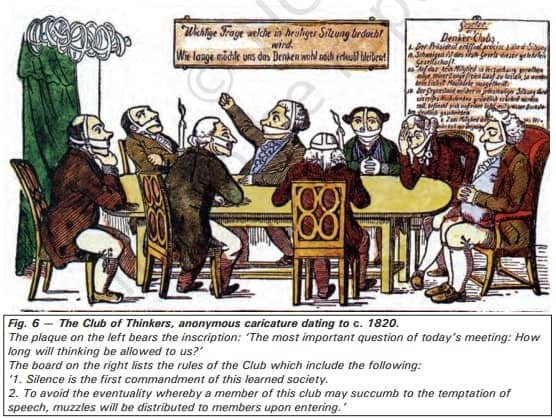The Making of Nationalism in Europe Concept & Free PDF Notes
Topic & sub-topics covered: The Making of Nationalism in Europe, The Aristocracy and the New Middle Class, What Did Liberal Nationalism Stand for?, A New Conservatism after 1815, and The Revolutionaries: The Rise of Nationalism in Europe (All single detail notes that are exam-oriented)
We have discussed in-depth and exam-oriented pointers that can be asked in the board exam of class 10th about “The Making of Nationalism in Europe” which is taken from the NCERT History book for class 10th and chapter no. 1st “The Rise of Nationalism in Europe”.
Download the PDF of NCERT for Class 10th Social Science History Notes Chapter 1 – The Rise of Nationalism in Europe
We have attached the class 10 history chapter 1 notes pdf “the rise of nationalism in Europe notes pdf” in this blog you can download it from our website for quick revision for your examination.
The Making of Nationalism in Europe
1. Mid-18th Century Europe Map:
- No Nation-States: Absence of modern nation-states.
- Division: Germany, Italy, and Switzerland are divided into autonomous territories.
2. Diversity in Eastern and Central Europe:
- Autocratic Monarchies: Ruled diverse peoples.
- Lack of Collective Identity: Different languages, ethnic groups.
- Habsburg Empire Example: Patchwork of regions with diverse languages and cultures.
3. Habsburg Empire Diversity:
- Territories: Alpine regions, Bohemia, Lombardy, Venetia, Hungary, Galicia.
- Language Diversity: German, Magyar, Polish, Italian, and various dialects.
- Subject Peasant Peoples: Bohemians, Slovaks, Slovenes, Croats, Roumans.
- Unity Tie: Common allegiance to the emperor.
4. Challenges to Political Unity:
- Differences: Linguistic, ethnic, and cultural.
- Promotion of Unity: Hindered by diversity.
- Common Allegiance: Sole tie among diverse groups.
🗒️ Summary of “The Making of Nationalism in Europe“
The map of mid-18th-century Europe lacked nation-states, with Germany, Italy, and Switzerland divided into autonomous territories. Eastern and Central Europe, under autocratic monarchies, faced diversity in languages and ethnic groups. The Habsburg Empire exemplified this diversity, with territories like Bohemia, Hungary, and Galicia. Such differences posed challenges to political unity, and the only common tie was allegiance to the emperor.
A Few Significant/Important Dates
I. 1797: Napoleon invades Italy; Napoleonic wars begin.
II. 1814-1815: Fall of Napoleon; the Vienna Peace Settlement.
III. 1821: Greek struggle for independence begins.
IV. 1848: Revolutions in Europe; artisans, industrial workers and peasants revolt against economic hardships; middle classes demand constitutions and representative governments; Italians, Germans, Magyars, Poles, Czechs, etc. demand nation-states.
V. 1859-1870: Unification of Italy.
VI. 1866-1871: Unification of Germany.
VII. 1905: Slav nationalism gathers force in the Habsburg and Ottoman Empires.
Answer this question if you know the answer:
Q. How did nationalism and the idea of the nation-state emerge?
Ans: Nationalism and the concept of the nation-state surfaced amid the culturally and regionally diverse communities in Europe. The rise of the middle class, including entrepreneurs, professionals, industrialists, labourers, and working-class individuals, was a consequence of industrialization and societal transformation. Among these, the educated individuals envisioned uniting culturally compatible segments of the population in Europe, giving rise to nationalism and the emergence of the notion of the nation-state.
The Aristocracy and the New Middle Class
1. Dominant Social Class:
- Landed Aristocracy: Prevailed socially and politically.
- Common Lifestyle: United across regions, French-speaking, marriage connections.
- Numerical Size: Small but powerful group.
2. Majority Population:
- Peasantry: Constituted the majority.
- Landholding Patterns: Tenants and small owners in the west, vast estates with serfs in the east.
3. Industrial Growth Impact:
- Western and Central Europe: Industrial production and trade led to town growth.
- Commercial Classes: Emerged based on market-oriented production.
4. Timing of Industrialization:
- England: Started in the second half of the 18th century.
- France and Parts of Germany: Occurred in the 19th century.
5. New Social Groups:
- Working-Class Population: Emerged with industrialization.
- Middle Classes: Industrialists, businessmen, professionals.
6. Regional Variation:
- Central and Eastern Europe: Smaller industrial and commercial groups until the late 19th century.
7. Role of Educated Middle Classes:
- Ideas of National Unity: Gained popularity among the educated, liberal middle classes.
- Post-Aristocratic Privileges: Abolition triggered the rise of these ideas.
Summary of “The Aristocracy and the New Middle Class“
The landed aristocracy, socially and politically dominant, shared a common lifestyle and language. Peasantry formed the majority, with varying landholding patterns. Industrial growth in Western and Central Europe led to the emergence of commercial classes. The timing of industrialization varied, with England starting in the 18th century and France/Germany in the 19th century. New social groups, including a working-class population and middle classes, emerged. In Central and Eastern Europe, these groups were smaller until the late 19th century. Ideas of national unity gained traction among educated, liberal middle classes after the abolition of aristocratic privileges.
What did Liberal Nationalism Stand for?
1. National Unity and Liberalism:
- National unity in early-nineteenth-century Europe was linked to the ideology of liberalism.
- Liberalism is derived from the Latin root “liber,” meaning free.
- For the middle classes, liberalism represented individual freedom, equality before the law, and government by consent.
- Politically, liberalism aimed at ending autocracy, and clerical privileges, and advocating for constitutional and representative government.
2. Political Rights and Universal Suffrage:
- Despite advocating equality before the law, liberalism did not necessarily support universal suffrage.
- In revolutionary France, political rights were initially granted only to property-owning men.
- Women and non-propertied men organized movements for equal political rights in the nineteenth and early twentieth centuries.
3. Economic Liberalism:
- In the economic sphere, liberalism emphasized freedom of markets and the removal of state-imposed restrictions on the movement of goods and capital.
- Emerging middle classes in the nineteenth century demanded the abolition of obstacles to economic exchange and growth.
4. Economic Challenges in German-speaking Regions:
- In the German-speaking regions in the first half of the nineteenth century, Napoleon’s administrative measures led to a confederation of 39 states with numerous customs barriers.
- Merchants faced challenges, including passing through 11 customs barriers with customs duties at each one.
5. Formation of Customs Union (Zollverein):
- In 1834, a customs union (Zollverein) was formed at the initiative of Prussia, joined by most German states.
- The union aimed to abolish tariff barriers, reduce currencies from over thirty to two, and create a unified economic territory.
- The formation of the customs union facilitated the unhindered movement of goods, people, and capital.
6. Economic Nationalism and Railway Network:
- Economic nationalism emerged, strengthening wider nationalist sentiments.
- The customs union, along with the creation of a network of railways, stimulated economic mobility and contributed to national unification.
Summary of Important Topic for Exam from this Topic “What Did Liberal Nationalism Stand for?“
- Understand the close association between ideas of national unity and liberalism.
- Recognize that while liberalism emphasized individual freedom and equality before the law, it did not necessarily support universal suffrage.
- Grasp the economic aspects of liberalism, particularly the demand for the freedom of markets and the removal of state-imposed restrictions.
- Comprehend the economic challenges faced in the German-speaking regions and how the formation of the customs union addressed these challenges, fostering economic nationalism and contributing to national unification.
A New Conservatism after 1815
1. Spirit of Conservatism after Napoleon’s Defeat (1815):
- European governments embraced conservatism post-Napoleon’s defeat in 1815.
- Conservatives aimed to preserve traditional institutions like the monarchy, Church, social hierarchies, property, and the family.
- Modernization, as perceived by conservatives, could strengthen traditional institutions such as the monarchy, making state power more effective.
2. Conservative Realization and Modernization:
- Conservatives recognized that modernization, influenced by changes initiated by Napoleon, could reinforce traditional institutions.
- Elements like a modern army, efficient bureaucracy, dynamic economy, and the abolition of feudalism and serfdom were seen as means to strengthen autocratic monarchies.
3. Congress of Vienna (1815) and Treaty of Vienna:
- Representatives of European powers (Britain, Russia, Prussia, Austria) met at Vienna in 1815 to settle post-Napoleonic changes.
- Hosted by Austrian Chancellor Duke Metternich, they formulated the Treaty of Vienna with the aim of undoing Napoleonic war-induced alterations.
- Key outcomes included the restoration of the Bourbon dynasty, territorial adjustments, and preventive measures against French expansion.
4. Restoration of Monarchies and Creation of a Conservative Order:
- The main objective of the Congress of Vienna was to restore monarchies overthrown by Napoleon.
- The resulting conservative order in Europe aimed at establishing autocratic regimes to maintain stability.
5. Autocratic Nature of Conservative Regimes:
- Conservative regimes established in 1815 were characterized by autocracy.
- These regimes did not tolerate criticism, or dissent, and sought to curb activities challenging the legitimacy of autocratic governments.
6. Censorship Laws and Control:
- Conservative regimes imposed censorship laws to control expression in newspapers, books, plays, and songs.
- Censorship targeted ideas associated with liberty and freedom linked to the French Revolution.
7. Liberal-Nationalists and Freedom of the Press:
- Despite conservative efforts, the memory of the French Revolution inspired liberals.
- Liberal nationalists, critical of the new conservative order, advocated for freedom of the press as a major issue.
Summary of Important Topic for Exam from this Topic “A New Conservatism after 1815“
- Understand the principles of conservatism post-Napoleon’s defeat, focusing on preserving traditional institutions and the role of modernization.
- Grasp the outcomes of the Congress of Vienna and the Treaty of Vienna, emphasizing the restoration of monarchies and the creation of a conservative order.
- Comprehend the autocratic nature of conservative regimes, their use of censorship laws, and the challenges posed by liberal nationalists, especially regarding freedom of the press.

The Revolutionaries
1. Post-1815 Scenario and Fear of Repression:
- After 1815, liberal-nationalists faced the fear of repression and persecution.
- Many liberal-nationalists operated underground due to the repressive political climate in European states.
2. Emergence of Secret Societies:
- Secret societies were formed across European states to train revolutionaries and disseminate liberal ideas.
- These secret societies played a crucial role in opposing the monarchical forms established after the Vienna Congress.
3. Revolutionary Commitment:
- Being revolutionary during this period meant committing to opposing the established monarchical order and advocating for liberty and freedom.
- Revolutionaries sought the creation of nation-states as an integral part of the struggle for freedom.
4. Giuseppe Mazzini and Young Italy:
- Giuseppe Mazzini, an Italian revolutionary born in Genoa in 1807, was a prominent figure.
- Mazzini was a member of the secret society of the Carbonari and played a key role in attempting a revolution in Liguria in 1831.
- He founded two underground societies: Young Italy in Marseilles and Young Europe in Berne, uniting like-minded individuals from Poland, France, Italy, and the German states.
5. Mazzini’s Vision of Nation-States:
- Mazzini believed that nations were the natural units of mankind, ordained by God.
- He advocated for the unification of Italy into a single republic within a broader alliance of nations as the basis for Italian liberty.
6. Influence Beyond Italy:
- Mazzini’s ideas and model inspired the creation of secret societies in Germany, France, Switzerland, and Poland.
- The overarching theme was opposition to monarchy and the pursuit of democratic republics.
7. Opposition from Conservatives:
- Mazzini’s relentless opposition to monarchy and his vision of democratic republics earned him the label of the “most dangerous enemy of our social order” by Metternich.
Summary of Important Topic for Exam from this Sub-Topic “The Revolutionaries“
- Understand the context of fear and repression faced by liberal-nationalists post-1815.
- Recognize the role of secret societies in training revolutionaries and spreading liberal ideas against the established monarchical order.
- Focus on Giuseppe Mazzini’s life, his involvement in the Carbonari, and the founding of Young Italy and Young Europe.
- Grasp Mazzini’s vision of nation-states, the influence of his ideas beyond Italy, and the opposition he faced from conservatives like Metternich.

